Jerusalem, Masada & The Dead Sea, Shabbos
Day Five - Friday July 7th 2006 -  - Yom
Shee-she
- Yom
Shee-she
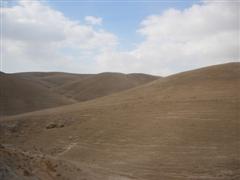 We started the day heading East out of Jerusalem. We passed Ma’aleh Adumim which is where I believe that Mitch and Lydia Rosner live, the friends of Rabbi Klestzick that we met last night. They are considering annexing it to Jerusalem along with the mountain in the middle between Ma’aleh Adumim which at the moment is not built up yet. This would provide some growing room for Jerusalem. At the moment Ma’aleh Adumim is NOT part of the plans for the inside of the wall, I don’t know why, but they are still considering it. We started the day heading East out of Jerusalem. We passed Ma’aleh Adumim which is where I believe that Mitch and Lydia Rosner live, the friends of Rabbi Klestzick that we met last night. They are considering annexing it to Jerusalem along with the mountain in the middle between Ma’aleh Adumim which at the moment is not built up yet. This would provide some growing room for Jerusalem. At the moment Ma’aleh Adumim is NOT part of the plans for the inside of the wall, I don’t know why, but they are still considering it.
Gadi said that George Bush has been quiet on the subject, maybe as he should be in this case. There is still a lot of political wrestling going on in the courts as to where to build the wall.
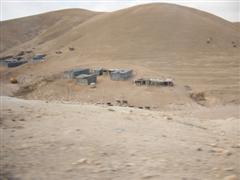 We headed towards Masada on
Route 1. The land turned from densely populated, to sparsely populated, to rocky (with Bedouin
villages - see right). We came up on the Mountains of Judah which
appeared to be completely inhabitable. We passed Jericho on Route 1 and then made a right on
Route 90 at the Dead Sea. The Dead Sea is 1200 feet below sea level.
"Dead" is a very accurate way to describe it. The first thing that I noticed was that there
were NO boats on this sea! It’s not a small sea, it is quite large. The average distance from Israel to Jordan is some 10-12 miles. The concentration of salt
in the Dead Sea is 10 times that of normal sea water. Nothing is capable of living in, or around, this sea. We headed towards Masada on
Route 1. The land turned from densely populated, to sparsely populated, to rocky (with Bedouin
villages - see right). We came up on the Mountains of Judah which
appeared to be completely inhabitable. We passed Jericho on Route 1 and then made a right on
Route 90 at the Dead Sea. The Dead Sea is 1200 feet below sea level.
"Dead" is a very accurate way to describe it. The first thing that I noticed was that there
were NO boats on this sea! It’s not a small sea, it is quite large. The average distance from Israel to Jordan is some 10-12 miles. The concentration of salt
in the Dead Sea is 10 times that of normal sea water. Nothing is capable of living in, or around, this sea.
Gadi explained the tremendous amount of “runoff” that occurs from only 2” of rain per year on these enormous rocky cliffs of the Judean Mountains. Normally the rain occurs very quickly resulting in flash flooding. The movement of the natural water, and the details of sources of water has been the topic of much discussion. I don’t think that many people in Richmond even know where the reservoir is, much less how their drinking water is obtained other than turning on a tap. In Israel, it is of utmost
importance. Water is like currency. Even more so, it is a matter of life and death. I just got thirsty and asked Amy Beth to pass the water (as I was writing this journal) and already, it’s a discussion!
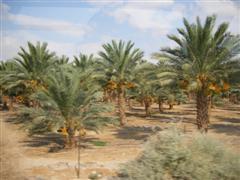 On rt. 90, we passed several farms of palm trees growing dates. It was the most unusual landscape, on the left was a beautiful sea, on the right were barren cliffs – the Judean cliffs, hundreds of feet in the air, and immediately to our right (at the bottom of the cliffs) were a mixture of rocky ground
with no life whatsoever, and these date farms with palm trees. We passed Ein
Gedi. On rt. 90, we passed several farms of palm trees growing dates. It was the most unusual landscape, on the left was a beautiful sea, on the right were barren cliffs – the Judean cliffs, hundreds of feet in the air, and immediately to our right (at the bottom of the cliffs) were a mixture of rocky ground
with no life whatsoever, and these date farms with palm trees. We passed Ein
Gedi.
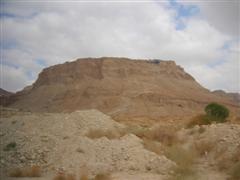 We
then entered Masada, we parked, and went into a beautiful building dedicated to the tourists that come to Masada. Masada was basically the southeastern lookout point for the Israeli border. It was picked
for this purpose since the mountain (or more accurately, cliff) of Masada stands out from the rest of the Judean
cliffs and is nearly impossible to attack. It has a relatively flat top. We took a cable ride to the top which only took a few (maybe
2 or 3) minutes. We
then entered Masada, we parked, and went into a beautiful building dedicated to the tourists that come to Masada. Masada was basically the southeastern lookout point for the Israeli border. It was picked
for this purpose since the mountain (or more accurately, cliff) of Masada stands out from the rest of the Judean
cliffs and is nearly impossible to attack. It has a relatively flat top. We took a cable ride to the top which only took a few (maybe
2 or 3) minutes.
 Once at the top, Gadi explained the various structures to us, including the water cistern, the storage units, the steam baths, the royal palace (built for King Herod), the mikvahs (there were 9 of them – probably erected after the Romans abandoned Masada), the water gate (also demonstrating how the channels would collect the runoff and divert them into cisterns built into the bedrock of Masada. He showed us where the main defense wall was and the ramp where the Romans built so that they could push a battering ram up and destroy the wall and enter Masada after the long siege. Once at the top, Gadi explained the various structures to us, including the water cistern, the storage units, the steam baths, the royal palace (built for King Herod), the mikvahs (there were 9 of them – probably erected after the Romans abandoned Masada), the water gate (also demonstrating how the channels would collect the runoff and divert them into cisterns built into the bedrock of Masada. He showed us where the main defense wall was and the ramp where the Romans built so that they could push a battering ram up and destroy the wall and enter Masada after the long siege.
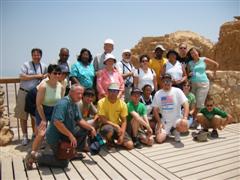 The whole Masada episode took place after the Jewish revolt of 66 CE, followed by the destruction of the 2nd temple in 70 CE, followed by Masada in 73 or 74 CE. Josephus Flavious was a writer who was considered a traitor to the Jews. A Jew himself, he decided that the temple would be destroyed and then distanced himself from the Jews. He asked to ride along with the Romans, which he did, and according to Gadi, became the first embedded reporter! The whole Masada episode took place after the Jewish revolt of 66 CE, followed by the destruction of the 2nd temple in 70 CE, followed by Masada in 73 or 74 CE. Josephus Flavious was a writer who was considered a traitor to the Jews. A Jew himself, he decided that the temple would be destroyed and then distanced himself from the Jews. He asked to ride along with the Romans, which he did, and according to Gadi, became the first embedded reporter!
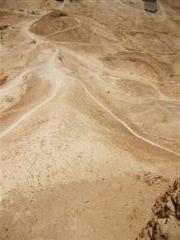 Josephus was the one who recounted the events on Masada including the speech by Alazar ben Yair which resulted in the decision for the people of Masada to take their own lives rather than have their wives raped by the Romans and either be taken into slavery or killed by the Romans. Josephus was the one who recounted the events on Masada including the speech by Alazar ben Yair which resulted in the decision for the people of Masada to take their own lives rather than have their wives raped by the Romans and either be taken into slavery or killed by the Romans.
Since Masada is a virtual cliff, there was
no way for the Romans to ascend it and take the Jews, so they laid siege
to it. Eventually, they built up a ramp, which is still there today
(see left) since there is so little rain, the ramp hasn't
disintegrated. Much of the original wood used to create the ramp is
still there. They used this ramp to push a battering ram up to
destroy the main wall on the West side. A fire also helped to
destroy the wall. The Romans decided NOT to proceed into Masada until the next day, giving the Jews of Masada the night to carry out their last act of courage. The account of the speech, as told by Josephus Flavious, may or may not be completely accurate. He might have taken, as they do in many Hollywood movies, some
"directorial leeway."
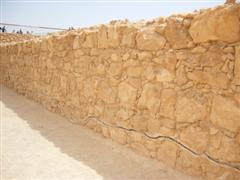 The ruins of Masada were not caused by the Romans as it was not necessary for them to destroy it. Everyone (except for two women and three children – I believe)
were already dead when the Romans entered Masada the next day after breaching the defense wall. The actual destruction was caused by a massive earthquake. Most of the ruins were about 1/3 of their original size (denoted by the winding and thick black line on the structures), yet a wonderful restoration project was performed to bring Masada back to it’s pre-quake glory. Gadi told us that he was part of the project back in the mid sixties. The ruins of Masada were not caused by the Romans as it was not necessary for them to destroy it. Everyone (except for two women and three children – I believe)
were already dead when the Romans entered Masada the next day after breaching the defense wall. The actual destruction was caused by a massive earthquake. Most of the ruins were about 1/3 of their original size (denoted by the winding and thick black line on the structures), yet a wonderful restoration project was performed to bring Masada back to it’s pre-quake glory. Gadi told us that he was part of the project back in the mid sixties.
Thought: I’m not sure that I agree that Masada was courageous. Based on halachic principles, I’m not sure it was the right thing to do either. The Rabbi recommended a book that deals with the questions of suicide in the face of a “to kill or be killed” scenario.
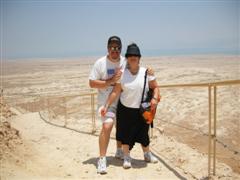 You can actually make cell phone calls atop Masada, I thought that was a bit strange. This would definitely qualify as the
"middle of nowhere," yet I could get better reception here than at the intersection of Gaskins and Pump!
Both Bob Schneider and Gadi received several calls. I was kind of regretting not bringing the phone as it would have been cool to make a call from the top of
Masada. You can actually make cell phone calls atop Masada, I thought that was a bit strange. This would definitely qualify as the
"middle of nowhere," yet I could get better reception here than at the intersection of Gaskins and Pump!
Both Bob Schneider and Gadi received several calls. I was kind of regretting not bringing the phone as it would have been cool to make a call from the top of
Masada.
A small group of us broke off from the pack and decided to walk down Masada. Speaking not from direct experience, but from common sense, it is MUCH EASIER to walk down than up, although it was hard on the knees. It took us about 40 minutes to make it to the bottom taking several breaks for pictures. The group of us that hiked down the “Snake Path”
 (shaped like a serpentine) included Me, Amy Beth, Frances and Larry, Sam, Mike, Chris, Dane, Daniel, and Angel. Angel was the last one to
join us, and made our 10th person, so we dubbed our group, “The Snake Path Minyan!” The view coming down (looking down and back up) was again breathtaking. You could see the beautiful Dead Sea in the background. The heat was extremely hot
(around noon and probably 100º Fahrenheit) and the glass of freshly squeezed orange juice at the bottom was incredibly refreshing. We then ate lunch at the restaurant in Masada, which was fairly
good, but potentially not kosher since they are open on weekends. (shaped like a serpentine) included Me, Amy Beth, Frances and Larry, Sam, Mike, Chris, Dane, Daniel, and Angel. Angel was the last one to
join us, and made our 10th person, so we dubbed our group, “The Snake Path Minyan!” The view coming down (looking down and back up) was again breathtaking. You could see the beautiful Dead Sea in the background. The heat was extremely hot
(around noon and probably 100º Fahrenheit) and the glass of freshly squeezed orange juice at the bottom was incredibly refreshing. We then ate lunch at the restaurant in Masada, which was fairly
good, but potentially not kosher since they are open on weekends.
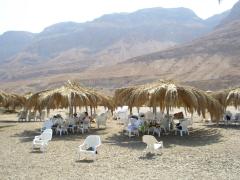 We moved on to the “Ahava”
(which means love) factory, which is the company that is exclusively licensed to mine the Dead Sea salts and minerals for beauty products. We watched a short movie (so we could get free passes to the beach area), bought some Ahava products (at a nice discount!) to take back to the states, and went to a beach to go into the Dead Sea. We moved on to the “Ahava”
(which means love) factory, which is the company that is exclusively licensed to mine the Dead Sea salts and minerals for beauty products. We watched a short movie (so we could get free passes to the beach area), bought some Ahava products (at a nice discount!) to take back to the states, and went to a beach to go into the Dead Sea.
I was really looking forward to this moment. I had learned as a little boy at the Richmond Hebrew Day School about the fact that one cannot sink in the Dead Sea. I was finally here and I was hot and sweaty from the walk down Masada so I thought that this would be quite refreshing. Well, it was more interesting than refreshing. You have to wear sandals or water shoes
to protect your feet from the rocks leading to the opening of the beach. As you walk in, it initially feels like any other body of water, except it was incredibly warm.
Considering how hot the air was that day, and the expectation of a
refreshing dip, the warm salty sea water was a bit uncomfortable.
As you proceed into the sea, you lose your footing and start to float. I could not stand in just four feet of water, the buoyancy of the sea lifted me straight up and allowed me to basically stand in place with my feet off of the ground! I leaned back and found myself floating, unable to sink, just like I was told as a
boy! I turned over on my stomach - same thing. It’s like something is holding you up in the air at the VERY TOP of the water! I got a single drop of the
salty water in my eye and it immediately began to sting. I knew that I couldn’t wipe my
eye with my salty fingers, so I waited a couple of minutes for my eyes to tear and get some
relief. It didn’t work. I had to get out of the Dead Sea and
flush my eye with some fresh water and then wipe it with a towel, which did fix the issue! I then went
back into the Dead Sea.
 We found
this very thick gooey mud towards the right hand side of the beach. Louis, Dane and I put mud (from the bottom) all over our bodies including our heads! We were completely covered in mud, and so we dubbed ourselves, the Mud-men! Think of it, the Mud-men came to life in the Dead Sea! For the rest of the trip, we would refer to ourselves as the Mud-men, which became synonymous with die-hard Israel tourists who lived our vacation to the fullest! Angel, Bonnie and Amy Beth joined in and put on the mud too! We found
this very thick gooey mud towards the right hand side of the beach. Louis, Dane and I put mud (from the bottom) all over our bodies including our heads! We were completely covered in mud, and so we dubbed ourselves, the Mud-men! Think of it, the Mud-men came to life in the Dead Sea! For the rest of the trip, we would refer to ourselves as the Mud-men, which became synonymous with die-hard Israel tourists who lived our vacation to the fullest! Angel, Bonnie and Amy Beth joined in and put on the mud too!
The Dead Sea is truly dead. They don’t have millions of people flocking to it for a reason. It is a very hard sea to enjoy. You can’t take a true relaxing “dip” in it, it is very hot, the salt makes cuts and eyes burn. On the interesting side, it is the only sea in the world that you cannot sink in, and the effects on beauty vis-a-vie the salt and the minerals are quite dramatic. It is also the lowest sea in the world as it sits 600 ft. below sea level.
Sodom and Gomorra were next to the Dead Sea, and Cleopatra used the sea for her beauty treatments, and supposedly didn’t let anyone, but her, go into the sea. Now that’s selfish!
We left the Dead Sea and began the 45 minute (or so) ride back to Jerusalem. The group then went to temple for Friday night services. I didn’t go, as I was exhausted. I
took a two hour nap and felt great for dinner. I was the only one who didn’t go, and I know that I missed out. Everyone was kvelling about how wonderful the service was, and how energetic the singing was at the temple they went to, located in a youth
hostel.
We all met back at the Dan Panorama, where we had a lovely Shabbat
dinner all at one big table. We shared our experiences together. I spoke with Mike Zogby and got to know him a bit. He reminds me of Aaron, young, intelligent and very interested in history and people.
I really do like this group!
[ Back ] [ Up ] [ Next ]
|